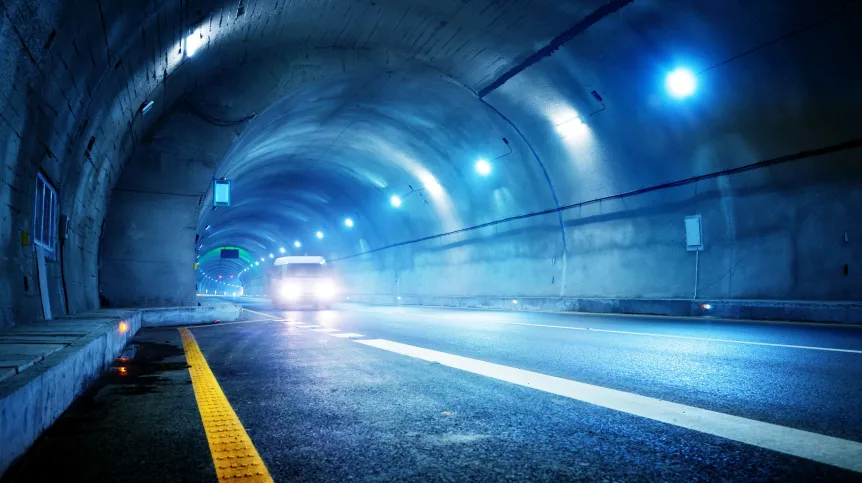
Today, tunnels are equipped with the latest security systems. The biggest problem is still people's behaviour, show the analyses conducted by a researcher from AGH University of Science and Technology in Kraków. 'Awareness of how to behave in tunnels is low', Dr. Natalia Schmidt-Polończyk says in an interview with PAP.
Dr. Natalia Schmidt-Polończyk from the Faculty of Civil Engineering and Resource Management of the AGH University of Science and Technology specialises in road tunnels. In her research, she is interested in issues at the intersection of safety engineering and psychology. She promotes science - she runs the podcast Bunkier Nauki (Science Bunker, www.youtube.com/@bunkiernauki) and the Instagram profile doktorka_tutorka, where she posts conversations with scientists from various fields. She is a finalist of the Science Popularizer competition.
PAP: Initially, you dealt with engineering, specifically ventilation, but over time you became more interested in behavioural issues.
Dr. Natalia Schmidt-Polończyk: Yes. It turns out that in dangerous situations in tunnels we often behave inappropriately or do nothing. Our instinct tells us to stay in the car, where - wrongly - we feel safe.
I confirmed this in research. First, I analysed reports from large fires. The largest one occurred in 1999 in the 12 kilometres long Mont Blanc tunnel. It started with the driver of a passenger car smoking a cigarette and throwing the butt out the window. It fell under the hood of a truck that carried flammable products: margarine and flour. The truck entered the tunnel and the driver realized that smoke was coming out from under the hood. He stopped the car halfway through the tunnel and fled on foot. The vehicles behind the truck were blocked, the drivers were sitting in their cars or standing next to them. There was more and more smoke, less and less oxygen. People die in tunnels not from fire, but from lack of oxygen and toxic gases.
PAP: Did the driver do the right thing by leaving the truck?
NS-P: Yes. He was the only one who survived the fire. 39 people died.
PAP: People do not escape in such situations?
NS-P: No. This was confirmed in my experiment, to which I invited about 60 students. I took them by bus to a 700-meter long tunnel in Laliki near Żywiec. A second, evacuation tunnel was dug along the road; passages to it are every 170 meters.
We simulated conditions like in a real fire. With one exception - the smoke was cold and non-toxic. During the first attempt, we entered the tunnel, the bus stopped and smoke appeared. An announcement came from the loudspeakers: there is a fire in the tunnel, please go to the emergency exit immediately. Sirens were howling, emergency lights were flashing - it was just one big disco. But my students were sitting on the bus. I recorded everything with hidden cameras.
PAP: Nobody got off?
NS-P: After a long time, one person decided to evacuate, then the group followed. After getting off the bus, this person looked around, checked the signs, and led the others to the emergency exit. Everything was visible because there was still little smoke.
Initially, the participants did not know that they were taking part in an experiment. I observed whether the infrastructure and signs were legible to them. Later they knew the situation, but I changed the conditions - for example, I increased the amount of smoke more and more.
In the second experiment, I checked how quickly the evacuation would take place, i.e. what the students had learned last time. The third time, I examined how smoke affected the speed of people moving in the tunnel. I asked them to evacuate as quickly as they could. They tried to do so, but were hampered by the thick smoke. It turned out that people move two thirds slower in a smoke-filled tunnel than in a clear one.
The fourth experiment was the most interesting one. After three attempts, the students thought that nothing would surprise them anymore. They entered the tunnel with their eyes closed, but the bus stopped 100 meters further than before. The smoke was so thick that when I stretched my hand out in front of me, I couldn't see my hand. I had to use thermal cameras. I saw how the group dispersed in such conditions. Students formed small groups and moved holding hands or backs. They lost their bearing, could not find an emergency exit, and went towards the fire.
After each attempt, I conducted a survey, and the students also reported their comments. They pointed out, for example, what a serious barrier the curb was in a smoke situation.
PAP: Should curbs in tunnels be removed?
NS-P: No. They ensure that no vehicle will run over the narrow sidewalk during evacuation. But they should be illuminated.
PAP: Does inappropriate behaviour often happen in tunnels?
NS-P: It does. After opening the tunnel in Zakopane, curious people stopped their cars to take photos. Rappers were shooting a music video - in a tunnel where traffic had not been stopped. There was also a boy who placed a camera on the road and performed acrobatics. Many people would drive in the opposite lane because they were tired of being stuck in traffic.
PAP: Do Poles know less about proper behaviour in tunnels than others?
NS-P: Things may be better abroad because there are more tunnels in other countries. Italians, Croatians and Scandinavians are more used to them. The longest road tunnel in the world is in Norway, 24 kilometres long. Its designers decided that such a long journey underground would not be comfortable for everyone. So it was divided with three caves illuminated in blue, with a yellow glow at the bottom. This light imitates a sunrise. When we pass through such a cave, the brain receives information: relax, the sun is rising. This gives the senses temporary relief.
But we usually cannot count on such special effects. Therefore, you must check the available information before entering the tunnel. Each tunnel 'tells' us a lot: before we enter, we have information about the length of the tunnel, the permissible speed, and the applicable minimum distance from the car in front. We also find out the radio frequency on which alerts will be broadcast on in the event of an emergency. There are also variable message signs on the displays - for example, if a cross is displayed, it means that we may not drive further in this lane. There are even variable message signs for the deaf in the Zakopane tunnel.
PAP: Let's assume that we receive information that something has happened in the tunnel. What should we do?
NS-P: If the vehicle behind you catches fire in the tunnel, you drive out. You can notify the services, but in newer tunnels the control centre sees everything. The systems are configured in such a way that even before the human eye sees something, the equipment already knows that a vehicle has slowed down or stopped. There is a dual video detection system in the Zakopane tunnel, i.e. one lens records everything in visible light, and the other is a thermal imaging camera useful in smoke conditions.
PAP: What if we are behind a car that is stuck?
NS-P: You have to pull over. Park the vehicle close to the right edge to leave a safety corridor. If a fire has just started out and there is no heavy smoke, you can try to extinguish the fire - there are fire extinguishers in the tunnel. If there is heavy smoke, get out of the car. The keys should be left in the ignition so that the services can move the car. Go as quickly as possible in the direction opposite to the source of the fire, to the emergency exit.
PAP: There used to be safety shelters in the Mont Blanc tunnel.
NS-P: Fortunately, they are not used anywhere now. Those were closed rooms with one exit - to the tunnel in which the fire was raging. They provided safety and oxygen for two hours, and the fire lasted 53 hours. Many people died in them. Many unfortunate events occurred during that accident. One portal (tunnel exit - ed. PAP) is on the Italian side, the other on the French side. The Italians were pumping air on one side and the French on the other, but they failed to communicate. The smoke had no way to escape, the oxygen fuelled the fire. A lot has changed in tunnel equipment since then; in 2004, the EU directive on minimum safety requirements came into force.
PAP: Do tunnel constructors still use those experiences?
NS-P: Yes. For example, the tunnel in Laliki has two-way traffic, i.e. one lane goes in one direction and the other in the opposite direction. If something happens, people should use the emergency exits that lead to the pedestrian escape tunnel. However, most tunnels in Poland are built with two two-lane aisles. Emergency passages lead to an adjacent tunnel, through which cars move in the opposite direction. When a fire breaks out in one nave, traffic in the other is closed to provide an evacuation route. This is how it is in Zakopianka, near Ursynów in Warsaw, in Gdańsk near the Martwa Wisła.
PAP: How long are the tunnels in Poland?
NS-P: Currently, the longest ones in Poland are just over two kilometres long. I am looking forward to the tunnel in Szczecin, which will be 5 km long.
PAP: Are they safe?
NS-P: So far, no serious accident has occurred in any of the Polish tunnels - except for the recent fire in the tunnel in Laliki, and fortunately no one was hurt. All such newly built structures must meet strict regulations and are packed with safety systems. But awareness of how we should behave in them is still low.
PAP: I think the reason is that nobody teaches it.
NS-P: It should definitely be a mandatory part of driving courses. I dream of introducing such knowledge into the school curriculum. The Ministry of Infrastructure could prepare an appropriate campaign, for example on social media. It would be great to collect universal tunnel safety rules somewhere.
PAP: Let us summarize these rules.
NS-P: Observe the speed limit. Maintain the appropriate distance from the vehicle in front of you. Not obvious: take off your sunglasses before entering the tunnel. When you take off your glasses, your eyes adapt more quickly to the lighting in the tunnel. Next - do not turn back and do not reverse. If the situation becomes dangerous, evacuate immediately and do not take anything with you. Do not enter the smoke, and you do find yourself in it, move close to the floor, on your knees.
PAP: You know tunnels inside and out. Do you like them?
NS-P: I'm crazy about them. When I drive through one, I record my observations with a voice recorder: there is aeration, mixed ventilation... I am also fascinated by the process of their construction. So much so that when a TBM (Tunnel Boring Machine) was recently brought from Spain to Rzeszów, I watched the transport and followed the transported elements.
PAP: Will there be more tunnels in Poland?
NS-P: I hope so, because it is worth investing in them. Look at Świnoujście, a city on islands. Communication with the rest of Poland used to be carried out by ferries, and the tunnel opened the world to the residents of Świnoujście. Another tunnel greatly improved traffic on the always congested Zakopianka road. (PAP)
PAP - Science in Poland, Anna Bugajska
abu/ zan/ kap/
tr. RL













